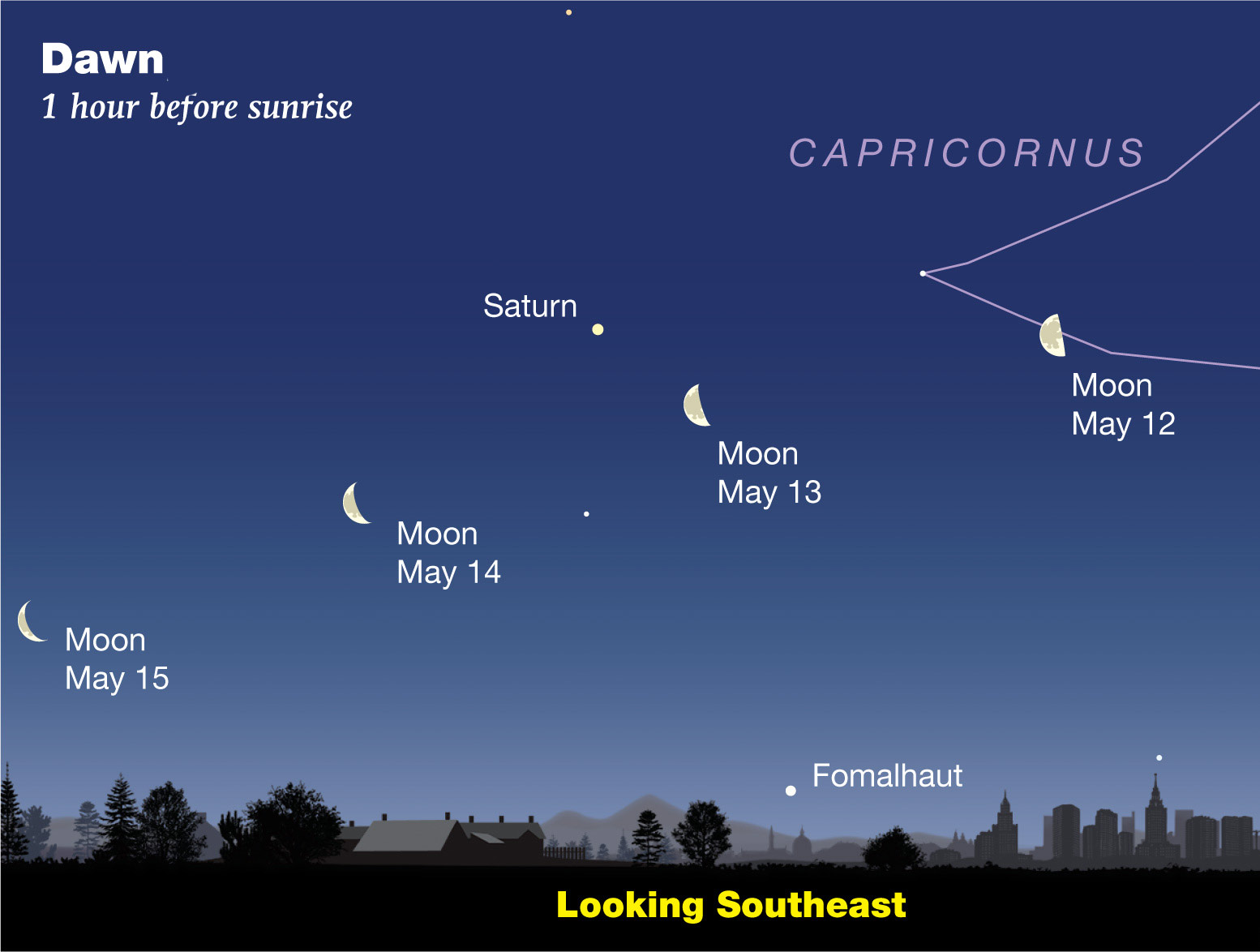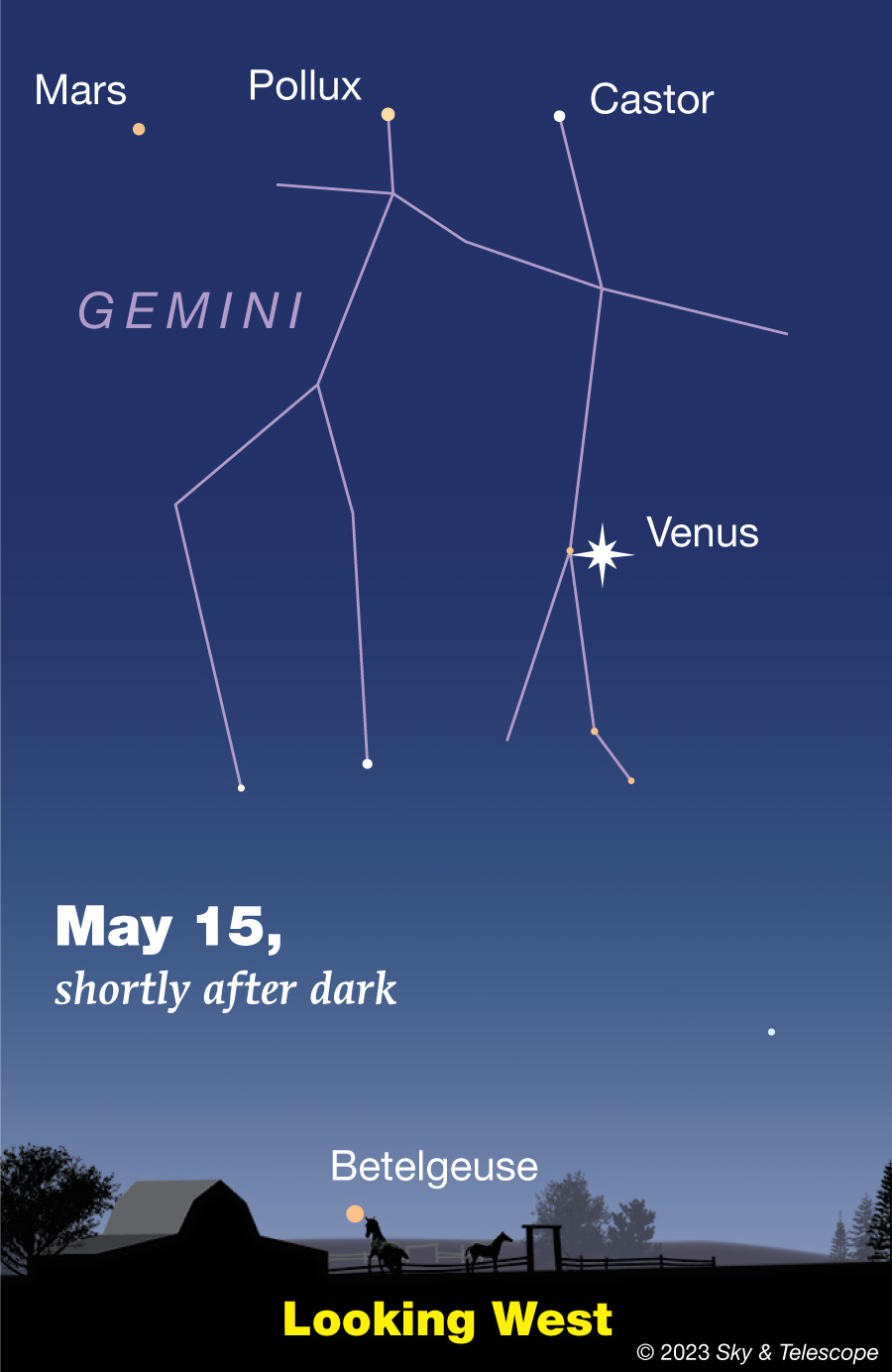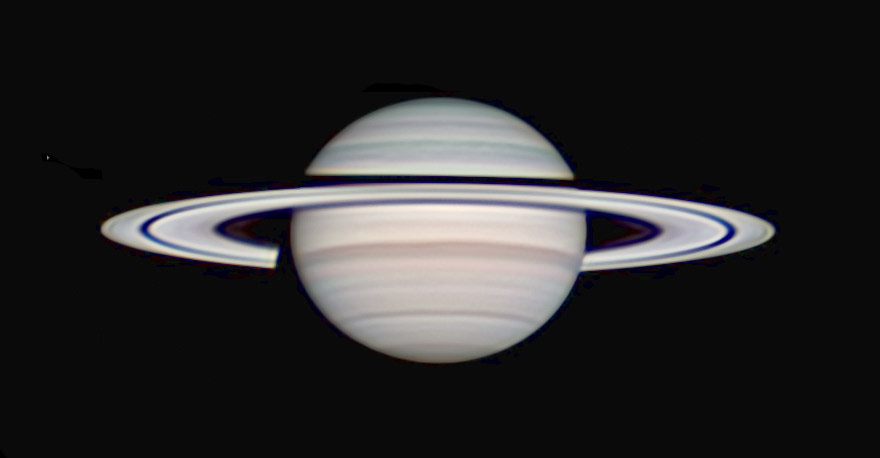FRIDAY, MAY 12
■ A gigantic asterism you might not know is the Great Diamond, some 50° tall and extending over five constellations. It now stands upright in the southeast to south after dusk.
Start with Spica, its bottom. Upper left from Spica is bright Arcturus. Almost as far upper right from Arcturus is fainter Cor Caroli, 3rd magnitude. The same distance lower right from there is Denebola, the 2nd-magnitude tailtip of Leo. And then back to Spica.
The bottom three of these stars, the brightest, form a nearly perfect equilateral triangle. We can call this the "Spring Triangle" to parallel to those of summer and winter. The first to name it such was (probably) the Sky & Telescope columnist George Lovi writing in the March 1974 issue.
■ Last-quarter Moon (exact at 10:28 a.m. May 12th EDT). The Moon rises tonight as late as 3 a.m. daylight saving time Saturday the 13th, already very slightly concave, with Saturn glowing a few degrees to its upper left. As dawn begins on Saturday they're higher and easier to see, as shown below.

SATURDAY, MAY 13
■ On these moonless spring evenings, you can use the Great Diamond to find the big, dim Coma Berenices star cluster. It's one of the nearest clusters at about 280 light-years, which accounts for its apparent size. If you have a moderately dark sky, or binoculars, look halfway from Cor Caroli to Leo's tail-tip Denebola. The cluster spans some 4°, about the size of a ping-pong ball held at arm's length. In a medium-decent sky it's a large, slight enhancement of the skyglow. In a good dark sky its brightest stars form an upside-down Y of an asterism. The cluster nearly fills a binocular's field of view. See Fred Schaaf's Evenings with the Stars column in the May Sky & Telescope, page 45.
SUNDAY, MAY 14
■ With the Moon gone from the evening, use binoculars or a telescope to see if you can spot the globular cluster M5, the Serpent's Gem, in Serpens Caput high in the southeast as evening grows late. At total magnitude 5.6, it's pretty easy in binoculars a moderately dark sky — if you know exactly where to look. Use the chart and the finding tips in Matt Wedel's Binocular Highlight column in the May Sky & Telescope, page 43.
MONDAY, MAY 15
■ May is the month when the Milky Way is altogether missing from the evening sky, for those of us living in the latitudes of the continental United States. That's because the Milky Way now lies all the way around the horizon in a circle, and the North Galactic Pole (in Coma Berenices) is overhead.
But wait up till late, and in a moonless sky like tonight's you can see the Milky Way start looming up into view all across the east.

Venus, currently stealing the show below them, tonight shines next to 3rd-magnitude Epsilon Geminorum — like Mars did back on April 14th (remember?).
Venus will take Mars's place on the Castor-Pollux line on June 1st.
TUESDAY, MAY 16
■ Mars lines up in its straightest line with Castor and Pollux this evening.
■ And, tonight Venus lies almost on a straight line between Capella far to its right and Procyon far to its left.
Go look. To check the straightness of both lines for the next evening or two, hold a straightedge up to the sky or stretch a string tightly between your two hands. Note: Don't be misled by comparing the long Procyon-Venus-Capella line to the straight line of the horizon. The celestial sphere is a sphere, and thereby lie illusions.1
■ A dawn challenge: About 30 minutes before sunrise Wednesday morning the 17th, use binoculars to look for Jupiter very low in the east with the extremely thin crescent Moon very close by to its right or upper right. The Moon's position with respect to Jupiter will depend on where you are.
And then the Moon's bright limb will occult Jupiter in daylight Wednesday morning for most of North America; in dawn light close to the West Coast. Map and timetables. In daylight you'll need a telescope and very clear air, but at least they'll be higher up. Binoculars in daylight may help to locate the thin Moon.
WEDNESDAY, MAY 17
■ What is the oldest thing you have ever seen? For everyone in the world it's at least the Sun and other objects of the solar system, age 4.6 billion years. Everything on or near Earth's surface is much younger.
Next is Arcturus, which most people have surely seen whether they know it or not, since it's one of the brightest stars in the sky. It's a Population II orange giant, age about 7 billion years, just passing through our region of the Milky Way. There it is, very high toward the southeast or south these evenings.
Amateur astronomers have globular clusters. Most are older still, at least in part. The familiar M4 in Scorpius has been dated at 12.7 ±0.7 billion years by means of white dwarfs within it.
But individual stars that you can observe? For that you want Bob King's article In Search of Ancient Suns with its finder charts. Assigning dates to individual stars that have been around since the first eras after the Big Bang is still iffy; astronomers have to work from the near-absence of heavy elements in their spectra. But a 6th-magnitude star in Bootes and a 7th-magnitude star in Libra, both in binocular range, await you these May and June nights. They probably date from about 12½ billion and at least 13 billion years ago, respectively. These will probably be the oldest things you have ever seen or will. The Big Bang itself is well dated at 13.8 billion years.
One could pick nits. Pick a proton, any proton right in front of you, and it has very likely remained intact since the Big Bang's first millionth of a second. And what a variegated history it has seen!
THURSDAY, MAY 18
■ With the Moon not yet back in the evening sky, now's a fine time to get out the telescope and find the edge-on galaxy M108 and the planetary nebula M97, the Owl Nebula, just off one of the stars forming the Big Dipper's bowl high overhead. They're both 10th magnitude. Use Ken Hewitt-White's "Suburban Stargazer" article, chart, and photo in the May Sky & Telescope, page 54.
Note: The chart and photo have north up. When you're looking high in the northern sky, celestial north is down. It's the direction toward Polaris, as always.
FRIDAY, MAY 19
■ Bright Vega is now nicely up in the east-northeast after dark. Look for its faint little constellation Lyra, the Lyre, hanging down from it with its bottom canted to the right. Lyra's stars form a little equilateral triangle (Vega is one corner) and a parallelogram attached to the triangle's bottom.
■ New Moon (exact at 11:53 a.m. EDT).
SATURDAY, MAY 20
■ With summer still a month away (astronomically speaking), the last star of the Summer Triangle doesn't rise above the eastern horizon until about 10 or 11 p.m. That's Altair, the Triangle's lower right corner. Watch for Altair to clear the horizon three or four fists at arm's length to Vega's lower right.
The third star of the Triangle is Deneb, less far to Vega's lower left.
SUNDAY, MAY 21
■ This is the time of year when Leo the Lion starts walking downward toward the west right after dark, on his way to departing into the sunset in early summer. After nightfall, spot the brightest star fairly high in the west-southwest. That's Regulus, his forefoot.
Regulus is also the bottom of the Sickle of Leo: a backward question mark about a fist and a half tall that outlines the lion's leading foot, chest, and mane.
This Week's Planet Roundup
Mercury is hidden deep in the glow of sunrise.
Venus (magnitude –4.3, passing Pollux and Castor in Gemini) is the brilliant "Evening Star" in the west from twilight through late evening. This month it shines about as high in the dusk as it ever gets. It doesn't set until a good 2½ hours after dark.
In a telescope Venus is a dazzling little gibbous globe, 60% sunlit and 19 arcseconds in diameter. It's enlarging a little more every day while waning in phase. It'll be 50% lit in late May and will become a bigger, dramatically thinning crescent dropping low from mid-June through mid-July.
Mars glimmers near Pollux and Castor, upper left of Venus. Mars has faded to magnitude +1.5, a bit dimmer than Pollux and practically as faint as Castor. From left to right, Mars is orange, Pollux is paler yellow-orange, and Castor is white (and telescopically double).
Watch their configuration change daily. Mars lines up exactly with Pollux and Castor, to their left, on Tuesday evening the 16th.
Mars is nearly on the far side of its orbit from us, so in a telescope it's just a tiny, fuzzy blob 5 arcseconds in diameter.
Jupiter is beginning to emerge very low in the sunrise. Look for it very low in the east in the brightening dawn about 30 minutes before sunrise. Binoculars help.
Saturn (magnitude +1.0, in dim Aquarius) is low in the southeast before and during early dawn. Nothing else that bright is in its area.

Also notice the black on each side of the rings where they cross the planet's disk. The dark black south of (above) the rings is their shadow on the globe. The thinner, slightly grayer black to their north is the dim, sparse inner C ring, seen in front of the planet's bright face.
Uranus is in conjunction behind the Sun.
Neptune (8th magnitude) is still very low in the east-southeast when dawn begins.
All descriptions that relate to your horizon — including the words up, down, right, and left — are written for the world's mid-northern latitudes. Descriptions and graphics that also depend on longitude (mainly Moon positions) are for North America.
Eastern Daylight Time (EDT) is Universal Time minus 4 hours. UT is sometimes called UTC, GMT, or Z time.
Want to become a better astronomer? Learn your way around the constellations. They're the key to locating everything fainter and deeper to hunt with binoculars or a telescope.
This is an outdoor nature hobby. For a more detailed constellation guide covering the whole evening sky, use the big monthly map in the center of each issue of Sky & Telescope, the essential magazine of astronomy.
Once you get a telescope, to put it to good use you'll need a much more detailed, large-scale sky atlas (set of charts). The basic standard is the Pocket Sky Atlas (in either the original or Jumbo Edition), which shows all stars to magnitude 7.6.

Next up is the larger and deeper Sky Atlas 2000.0, plotting stars to magnitude 8.5; nearly three times as many. The next up, once you know your way around, are the even larger Interstellarum atlas (stars to magnitude 9.5) or Uranometria 2000.0 (stars to mag 9.75). And be sure to read How to Use a Star Chart with a Telescope. It applies just as much to charts on your phone or tablet as to charts on paper.
You'll also want a good deep-sky guidebook. A beloved old classic is the three-volume Burnham's Celestial Handbook. An impressive more modern one is the big Night Sky Observer's Guide set (2+ volumes) by Kepple and Sanner.
Can a computerized telescope replace charts? Not for beginners, I don't think, and not on mounts and tripods that are less than top-quality mechanically. And as Terence Dickinson and Alan Dyer say in their Backyard Astronomer's Guide, "A full appreciation of the universe cannot come without developing the skills to find things in the sky and understanding how the sky works. This knowledge comes only by spending time under the stars with star maps in hand."
![]() Audio sky tour. Out under the evening sky with your
Audio sky tour. Out under the evening sky with your
earbuds in place, listen to Kelly Beatty's monthly
podcast tour of the heavens above. It's free.
"The dangers of not thinking clearly are much greater now than ever before. It's not that there's something new in our way of thinking, it's that credulous and confused thinking can be much more lethal in ways it was never before."
— Carl Sagan, 1996
"Facts are stubborn things."
— John Adams, 1770
1. "The celestial sphere is a sphere, and thereby lie illusions." Beware of the tricky illusion that a line on the sky parallel to the horizon is a straight line. Nope! The horizon itself is a great circle around the celestial sphere, so it's straight as seen by a viewer at the center of the sphere, meaning you. But a circle drawn around the sky at some constant altitude above the horizon will be a small circle, not centered on you, so any segment of it will bend up toward the ends. This effect becomes substantial high above the horizon and/or when you're looking across a large span of sky.
Many people cannot believe that this is true. That's why to bring the straightedge or piece of string, rather than trying to judge a straight line from Procyon to Capella by eye — with the horizon sneakily enticing you to make it your reference line. Prove this to yourself!
 10
10









Comments
Yaron Sheffer
May 12, 2023 at 8:18 pm
Alan, allow me to nitpick your nitpicking. The challenge was to have seen the oldest thing. But, I doubt any one of us can readily see, nor pick, a single proton... 🙂
By the way, looking at M31 allows you to see its bright bulge, which is very similar in composition and age to globular clusters.
You must be logged in to post a comment.
Rod
May 13, 2023 at 12:12 pm
Still waiting to see some more clear skies at night for me 🙂 Who knows, may be Monday night 🙂
You must be logged in to post a comment.
Rod
May 15, 2023 at 10:31 pm
Observed 2000-2130 EDT. Sunset 2012 EDT. I enjoyed some 10x50 binocular and 90-mm refractor telescope time tonight viewing Venus, M5, and M13 globular clusters. At 71x, Venus distinct nearly half-moon shape. 59.8% illuminated and a bit more than 19 arcsecond size. Mathew Wedel Binocular Highlight in May 2023 Sky & Telescope issue features M5 in Serpens Caput. Easy to find and a good view. My 10-inch telescope is better for globular clusters but the 90-mm refractor on tripod easier to setup and take down. 10x50 binoculars nice views of M5 and M13. I located M13 in Hercules and closed the night by observing M13 at 71x. M5 and M13 showed some halo stars around the brighter cores, better than my 10x50 binoculars at 71x in the telescope view. Some fireflies were out. Skies clear, temperature 16C. Various satellites visible in polar orbits, equatorial orbits after sunset (too many IMO).
You must be logged in to post a comment.
mary beth
May 16, 2023 at 11:11 am
Hello Rod, I’m so glad to hear that the skies cleared off and you had such an enjoyable night. Very comfortable temperatures. I think we will be 90 or above tomorrow. Oh well, it’s summer in Texas!
Just yesterday I was reading up on global clusters, so fascinating! I read they were first ‘discovered’ in 1665, imagine the excitement! Will follow up on my reading today and view more images.
Very nice you have fireflies for already, I have not seen any yet. I guess they are like little ground stars lol.
I agree with you, there was are too many satellites!
You must be logged in to post a comment.
misha17
May 16, 2023 at 5:57 pm
Scientific American posted an article about Betelguese's recent variations in brightness. It mentions that in recent weeks, the star has been about 50%brighter than normal.
Link:
https://www.scientificamerican.com/article/betelgueses-brightening-raises-hopes-for-a-supernova-spectacle/
Looks like I/we need to go out tonight and judge for ourselves - weather permitting, of course.
You must be logged in to post a comment.
mary beth
May 17, 2023 at 3:25 pm
Good article, thank you
You must be logged in to post a comment.
Rod
May 17, 2023 at 6:05 am
I did enjoy some of the sky show this morning between Jupiter and the thin, waning crescent Moon in Pisces. Posted observation note here, https://skyandtelescope.org/astronomy-news/moon-jupiter-trifecta-conjunction-occultation-double-shadow-transit/#comment-386453
You must be logged in to post a comment.
mary beth
May 17, 2023 at 3:32 pm
My husband gets up early, so I copied Tuesday’s post about Jupiter and the moon and sent to his phone. He saw it easily with just his eyes, it was beautiful. He added, “Binoculars!?!! We don't need no stinking binoculars!!”
You must be logged in to post a comment.
Rod
May 18, 2023 at 9:09 am
mary beth, I use my 10x50 binoculars all the time, part of my observing even with telescopes 🙂
You must be logged in to post a comment.
mary beth
May 18, 2023 at 11:17 am
Oh yes, of course it’s always good to have them. Even more stunning! He was just being silly from that famous (now a pop culture) quote from the movie The Treasure of the Sierra Madre lol.
I suspect New Jersey Eclipse Fan will recognize it right away ;).
You must be logged in to post a comment.
You must be logged in to post a comment.